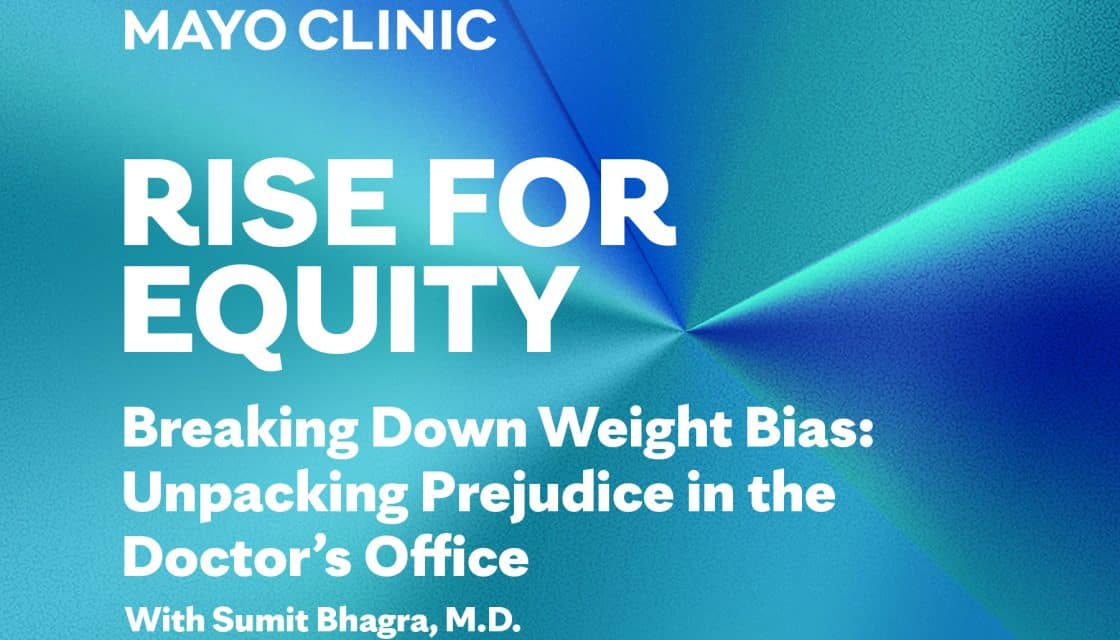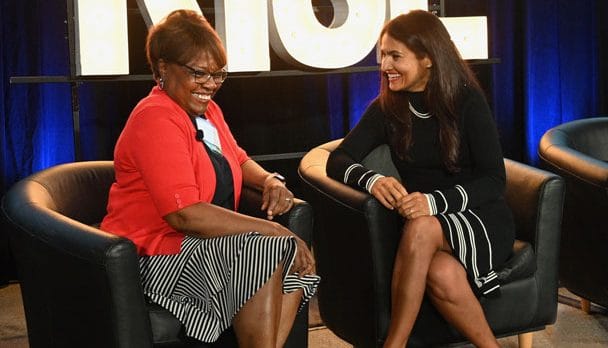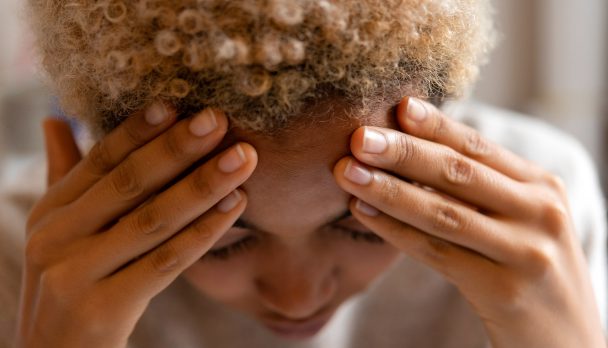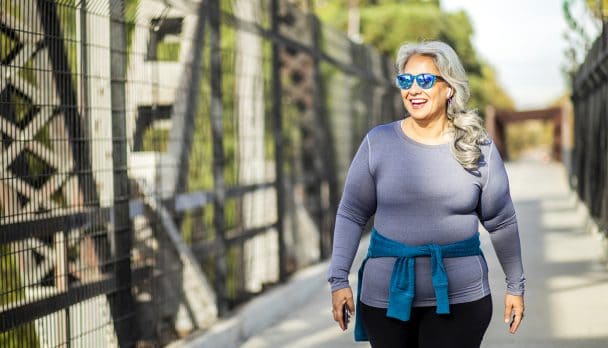
“If we introspect into the origin of the bias, we’ll notice that the belief that people are 100 percent in control of their body weight is probably the basis for the bias. Because if we truly understand the systemic nature of any health problems, particularly weight gain, we can probably empathize more with the person who lives in a larger body as opposed to blaming them for being in that shape.”
— Sumit Bhagra, M.D.
On this episode of the RISE for Equity podcast, Dr. Sumit Bhagra joins host Nicole Nfonoyim-Hara to discuss the topic of the issue of weight bias in healthcare and its profound health implications. Delving into the roots of weight bias, the discussion explores its detrimental effects on both physical and psychological well-being, examines responses to weight bias from both doctors’ and patients’ point of view, and advocates for actionable changes that can be implemented to support patients in achieving optimal health, no matter their size.
“As we look at how we’ve dismantled all the biases and the isms, weight bias is probably the most acceptable of the biases in our community. You don’t have to do much. Just look at any TV show or movie, and you’ll still see people being mocked because of their body weight. It’s the last of the isms standing, and we’ve got to work really hard to dismantle that as well.”
—Sumit Bhagra, M.D.
Guest: Sumit Bhagra, M.D. is the Chair of Endocrinology and Associate Medical Director of Contracting & Payer Relations for Mayo Clinic Health System. Follow him on Twitter @SumitBhagraMD or on LinkedIn.
Read the transcript:
Nicole Nfonoyim-Hara: Welcome to the “Rise for Equity” podcast. In this series, we’ll be talking to leading physicians, scientists, and innovators about what it’s going to take to transform healthcare for a more just, more equitable future. I’m Nicole Nfonoyim-Hara, your host on the “Rise for Equity” podcast. Today I’m joined by Dr. Sumit Bhagra. We’re discussing weight bias and stigma as a critical, but often overlooked issue in health equity and its impact on patients and healthcare professionals. Welcome, Dr. Bhagra.
Dr. Sumit Bhagra: Thank you for having me. Thank you, Nicole.
Nicole Nfonoyim-Hara: So as we begin here, Dr. Bhagra, I think it would be useful for us to have some shared language. Can you help us define weight bias?
Dr. Sumit Bhagra: Weight bias is negative attitudes and practices towards individuals solely based on their weight. It’s what they experience as the lengths through which they see their own existence. It has an impact on their outcomes, their experience, and how they feel. We’ll talk about that in more detail as we go along here.
Nicole Nfonoyim-Hara: Weight bias, as you know, is not something that’s often talked about, and even in equity spaces, it’s not something that is often centered. Why do you think that is, and how did you become particularly interested in weight bias in your own work and advocacy?
Dr. Sumit Bhagra: As we look at how we’ve dismantled all the biases and the isms, weight bias is probably the most acceptable of the biases in our community. You don’t have to do much. Just look at any TV show or movie, and you’ll still see people being mocked because of their body weight. It’s the last of the isms standing, and we’ve got to work really hard to dismantle that as well.
Nicole Nfonoyim-Hara: You mentioned popular culture having your response there, and we know that biases are informed by several different individual and societal factors like popular culture. In the case of weight bias, what are some of the other main roots of the bias as you see it?
Dr. Sumit Bhagra: I like to often say that bias is something that popular culture leaves as a residue on your mind, and this could be at a very young impressionable age of one or two-years-old. If we introspect into the origin of the bias, we’ll notice that the belief that people are 100 percent in control of their body weight is probably the basis for the bias.
Because if we truly understand the systemic nature of any health problems, particularly weight gain, we can probably empathize more with the person who lives in a larger body as opposed to blaming them for being in that shape.
Nicole Nfonoyim-Hara: I think it’s this idea around understanding, right? And we know our size, our weight, weight management, those things are really complicated. They’re very individual to the person. Can you share with us a bit more about how things like common medical advice that’s given, like eat better, move more, reinforces weight bias and does harm?
Dr. Sumit Bhagra: I think we, the medical community, have been guilty of following a very simplistic advice of if you only ate less and moved more, you would not be in this condition. Yet we know from research studies that if a thousand people enrolled in our intensive lifestyle change program, they’d end up losing five to seven percent of their body weight.
As the intensity of the program dissipates, they end up gaining weight back to their prior baseline. It is almost as if there are internal hormonal mechanisms that set the thermostat for a person’s body weight at a certain level, and while some people make it sound like it’s very easy to do, that is not the experience of the average person who tries really hard to get their weight off.
We all know our friend who could eat a whole pizza, and eat one pizza every day, and don’t gain weight. There are some people who do all the right things and yet weight loss seems to be relentless for them. That’s what got me interested in this field and how we blame people for something they don’t truly control. I mean, there’s certainly individual ownership, but it’s not a hundred percent in their control.
Nicole Nfonoyim-Hara: That’s a really important perspective. Because as you said there is certainly this idea that becomes really pervasive about one’s own responsibility, or the burden falling on people, to be able to be 100 percent responsible for managing their weight, and as you said, there’s so many other factors as well.
It does seem like the societal stigma around weight does impact everyone. It’s one of these biases that makes its way. While weight bias, specifically as you defined it, is directed toward people of a higher weight, how does internalized weight bias also impact those who may be considered, quote unquote, leaner or of a lower weight?
Dr. Sumit Bhagra: For example if somebody you see after six or seven months has lost a lot of weight, we don’t know what they’re facing. It could be a health problem, a cancer diagnosis, a lot of stress resulting in food deprivation, or socioeconomic factors are general responses.
“You look good.” Now, if you inspect that statement, we assume that if a person looks leaner or slimmer, they look good. To the people sitting right next to them, who may have gained weight over the past 10 months or so, they’re never told directly how you feel about them. But when we make these comments about you look great, you’re actually implying that the other person who may not have been as lucky at losing weight, or maybe facing other consequences, they don’t look so good.
Nicole Nfonoyim-Hara: you mentioned in your response here, socioeconomic factors, and we know that there’s all these intersections. Weight is one of the many things that describes us and is part of our identity. There’s also race and gender and so many other things. Do we see weight bias shaped by other factors specific to gender, race, or socioeconomic class?
Dr. Sumit Bhagra: Our mind is kind of a multivariable computer that looks at all these factors and brings in all the biases we have and blends them into this complex attitude we have for people towards people. Weight bias is acceptable, like I said. But if you factor in the color of the skin or the gender, how a person dresses, whether they’re wearing brand name clothes or shoes, those things tell a different story about their socioeconomic status. I think all of it comes together and perhaps compounds the way we view people as healthcare professionals, resulting in perhaps a greater severity of the bias they face.
Again, I think this is a slippery slope towards certain groups losing trust in healthcare systems and choosing not to come back to be seen for their care.
Nicole Nfonoyim-Hara: That trust piece is an important one and unfortunately science and medicine, of course, as you know, have played a role in reinforcing so many different types of biases and including weight bias in our society. In terms of the clinical setting specifically, can you give us some examples of how weight bias shows up when patients are seeking care?
Dr. Sumit Bhagra: Some of the ways in which it manifests are perhaps shorter appointments. Not being heard. You’re speaking and the doctor kind of gets up and says you need to lose weight and I will see you back in three months.
Your backache or headache or fill in the blank symptom is all related to you being overweight. The assumption being made is that a person who’s gained weight is either lazy or not motivated, and only if they pulled themselves up by their bootstraps life would be better for them.
The other way, which is unintentional, that shows up as weight bias is not having the right size door, a couch, a blood pressure cuff, an exam table that doesn’t hold a person more than 300 pounds, weighing people in the public, waiting areas or hallways. Then to complicate matters further, announcing their weight loudly as 10 other people can listen to you.
Those are some of the ways in which weight bias manifests. Oftentimes in my clinic, patients refuse to be weighed, and that’s often viewed with ridicule. Every patient has the right to refuse to be weighed if they don’t feel comfortable about the setting in which they’re being weighed.
The first step is to understand where people are coming from, and then being able to stand in their shoes, and perhaps exercise some empathy towards them.
Nicole Nfonoyim-Hara: Thank you for painting us that picture as you were walking through each of these examples in cases where it shows up, I mean, it’s language, it’s that treatment in the building of the relationship and that encounter in the clinical setting and things that many people might not even think about that are built into the environment of the physical space that you’re in when you’re getting treatment.
All of those things compounded can really impact someone psychologically, their well-being and their outcomes. You talked about shorter visits, right? So you’re not getting deeper questions and relationships with the patient around what might be going on. As we think about that, how has this current discrimination led to more serious implications like untreated illness?
Dr. Sumit Bhagra: Being subject to weight bias has both physical and psychological consequences, short term as well as long term. Looking at physical consequences, people end up delaying care. So if they have some chest pain or abdominal pain they might be reluctant to expose their body to an exam for the fear of being judged and may end up in the emergency department several days later when it might be too late, or some health consequences might have happened.
Another way in which this manifests is certain groups not seeking preventive care, things like mammograms, where you really have to be undressed and viewed by people as they examine that body part under radiological imaging. So, delayed mammograms, delayed preventive screening, delayed prostate exams, colonoscopies, and things of that nature, which ultimately translate into a higher prevalence of more advanced cancer seen in this group.
And psychologically speaking, people develop a low self-esteem based on how the world views them. There might be eating disorders or disordered eating. I think long term, there’s good data to show that adverse social experiences, when accumulated, result in a higher chance of diabetes, hypertension, and other chronic diseases as well.
So there’s intermediate short term consequences and then a lifetime of accumulated insults, traumas, microaggressions, and bias. Perhaps results in the internalized trauma resulting in physiological processes causing chronic disease as well.
Nicole Nfonoyim-Hara: You mentioned trauma. I know that another conversation around this topic is also around shame, which certainly has a psychological impact, and we’re talking about real lives and experiences here.
Weight bias is often so pervasive and steeped in how all of us are conditioned to think about weight, as patients how would you counsel a patient if they are trying to identify what they’ve experienced with weight bias and how to help them trust that those feelings are legitimate and that they can do something about it?
You mentioned in your own space that patients should be able to refuse being weighed, right? How do patients know that? How can they come forward and advocate for themselves in those positions?
Dr. Sumit Bhagra: Sometimes patients do share with me that they had a bad experience in another clinic, or another part of Mayo Clinic Health System where I practice, and I often try to understand how they felt and what mechanisms they might have. In the moment, I know it’s hard to talk directly with a physician to confront them or to a nurse practitioner because there’s a power differential and a hierarchy and they might feel that there might be retaliation or a breakdown of the patient-provider relationship.
Mayo Clinic and every healthcare facility has formal grievance processes, so patients are certainly encouraged to file that grievance because when the team arises that there’s a lot of biased behaviors going on, we can’t fix what we don’t know.
Filing a grievance is absolutely appropriate. There are online groups where patients can discuss their experiences. And I think in the end, it behooves the medical community itself to provide formal education, provide orientation to employees that it’s not okay to ridicule any aspect of somebody who lives in a different size body.
The sum total of all change requires every individual to change, and it really starts with the home, to school, to the employment place, advocacy, legislation. So it’s really the whole gamut of our lived human experience that needs to gradually change to dismantle something that’s been acceptable for the past 100 or so years. It’s not going to happen overnight. It might take a decade or so, and we’re making some good progress towards that change as well.
Nicole Nfonoyim-Hara: We’re talking specifically here around the clinical setting and in the healthcare setting, that’s one part of our lives. Something like this is, as you said before, it is really baked in so many different ways.
Language is such an important part of any conversation on bias. Specifically with weight bias, there are ways that most of us are taught to talk about, or not talk about; things like our bodies, size and weight. How do we develop more body affirming and inclusive language as healthcare professionals and as everyday people and how do we listen to and respond to how patients themselves might be self identifying?
Dr. Sumit Bhagra: Developing the muscle of language takes time. It probably starts with using very kind, empathetic language, understanding how a person feels. There’s a movement called Health at Every Size, where we focus on health centrism as opposed to weight centrism.
We’re obsessed with the BMI as a cutoff, as a number. So if you’re 29. 9, you’re overweight, and suddenly a pound heavier, 30, you’re obese. We don’t do our patients any justice by using language like morbidly obese. That’s an IC. D. 10 formal billing code that goes out. Patients can see it on their chart.
We actually don’t even feel the stigma of that language that we print off those diagnostic codes and hand them over to our patients directly. So we don’t have the muscle right now to even understand what that word does to the patient as we print it out and hand it over to them. So it’s going to take a lot of work.
It’s going to take a lot of education to build that language. But I think it goes down to the basics — treat people as you’d like to be treated. I often use a Maya Angelou quote that says, “People forget what you said, but they don’t forget how you made them feel.” So make sure every word that leaves our mouth is a therapeutic tool for the patient.
If it’s not kind, true or necessary, there’s other ways to say the same thing to get the message across without being hurtful to our patients. Some people might say the counterparty might say, “well, that’s a truth that needs to be heard.” Again, it goes back to individual responsibility versus complex socioeconomic factors and other factors playing a role.
So to see the person as a product of their circumstances, as opposed to being the actor in that movie, perhaps helps you reframe how you connect with those patients as well.
Nicole Nfonoyim-Hara: I loved your terminology of a therapeutic language or therapeutic response, because it is very restorative in that sense, right? It’s affirming. It is, I think again, in equity spaces, we’re always looking for the right term, the right thing to say, and your approach is a really empowering one because it is about kindness and compassion, things that we all want practice as humans on this earth and can continue to build that muscle around as we also continue to learn through the research, through being educated, through working with people that are having these experiences, what language is preferable, what language we can practice using.
So I think having both of those in place seems like a really wonderful way to take a step forward. I’m particularly interested too, I mean, we talked a little bit about the language and conditioning at the societal level, but there’s also, of course, within the medical field, the terminology that’s used on those forms that are given to patients. Those are specific to the medical and healthcare fields and they’re not neutral at all. They can be very harmful to a patient that’s seeing that because those words themselves have a stigma.
So what do you see as some specific changes that can be implemented, particularly in medical and healthcare education and training around this?
Dr. Sumit Bhagra: We have a large body of people who currently work as healthcare providers and to change them would take different strategies than the people currently in training. So if you implement some changes in the medical school curriculum, for example, or nursing curriculum, where either simulation-based or knowledge-based modules, so that future healthcare providers could understand, with nearly 50 plus percent patients being either obese or overweight, you’re going to see a person about a one in two chance, perhaps even a higher chance that is living at a weight that is higher than maybe conducive to what we call optimal medical health.
We know that many people with excess body weight are metabolically somewhat healthy, and there are people who are normal body weight, so called normal body weight, with lots of health problems.
So the relationship between body size and health is not linear. It’s not one to one. So as we develop the new professionals — the new crop of individuals think embedding that training into who they are from the get go would be really helpful. But then it takes a generation of new providers to come in and replace what we have today.
So we also have to supplement that by modules or simulation for current staff. I go to medical conferences and there’s hardly any mention of the psychological impacts of chronic disease, health stigma, diabetes, distress, things of that nature. There might be a talk on Friday afternoon when everyone’s taken their flight back home.
So they’re pushed back to the background and I think they need to be a bit more front and center as we educate people.
Nicole Nfonoyim-Hara: And, there does seem to be a growing field of research and studies in this area, even though they’re not as centered. Do you have any ones that you have found particularly helpful or others that people could use to learn more?
Dr. Sumit Bhagra: There are a couple of online resources that synthesize all the research. There are things like the Health at Every Size movement website, the Obesity Action Coalition website, which probably has a-15 page brochure that outlines things we can do as a medical system to make people feel welcomed, both in terms of language, the equipment, our facilities design, having the right type of equipment accommodations available for patients living in bigger bodies.
Nicole Nfonoyim-Hara: Yeah, it seems like such a small thing. Research and studies ultimately tell a story and we need more stories. You wrote a piece , and you started with a patient story and I think it’s important to continue to think about how we hear the patient stories and hear about the ways in which people are directly impacted by this issue.
What strategies and resources are you aware of that are available to support and empower some of that patient advocacy?
Dr. Sumit Bhagra: Patients should feel empowered to speak up anytime they recognize bias. The first step is to recognize the behaviors that actually amount to bias. I think patients give their health providers the benefit of the doubt and think they might be busy today, but if it happens every time and none of the symptoms or complaints are addressed appropriately, they may be facing weight bias.
One is to speak up. We talked about filing a grievance formally so that the perpetrator of that bias may have a blind spot and they may not realize how their words and actions come across. Thirdly, there might be advocacy groups or online support groups for people to find their community and speak. Because the voices have been silenced for years and decades and I then say people who really feel strongly about this could join advocacy groups at the community level, could host educational seminars.
There’s work to be done in terms of moving forward the legislature about that as well. I don’t know which states ban weight discrimination, but if there are rules that are existent that are not being implemented I think we ought to speak up and make sure this form of discrimination is banned as well and action taken upon pretty much like every other form that we have worked on for these past two or three decades.
Nicole Nfonoyim-Hara: Thank you for sharing that and the multifaceted nature of the different levels at which you can take this advocacy and the centering of this particular topic. We’ve been talking primarily about patients experiencing weight bias as a very significant issue. I was also just curious about any research on physicians and other providers experiencing weight bias.
Often in equity conversations, we talk a lot about representation and weight bias is a bit different in this sense. I was thinking about how often I see size diversity. How often I see size diversity in a clinical setting.
Does that matter and how would medical counsel be received from a provider who may be considered of a higher weight? Questions around, is there internalized pressure or shame to maintain a certain weight as a healthcare professional? Have you seen any of these conversations in the field as well?
Dr. Sumit Bhagra: One of the Mayo Clinic surveys, which is well known to us from 2015, people feel that if you live in a bigger body your opinions are not valued as much. You’re less likely to be promoted. It’s well known that people are viewed adversely, even if they have the exact same educational accomplishment or job performance, less likely to be promoted, less likely to be given managerial positions.
Over a lifetime. There’s a compensation gap as well. You end up at a slightly higher compensation level living in a smaller body. So these outcomes are really a manifestation of the biases as they select people who look a certain way, purely based on how they look and not based on what they can do for the organization.
So as you go up the chain from mid-level to high-level management, you will find more and more people not being size diverse. It’s complex.
But overall, the literature supports that the outcomes for people in employment are slightly more adverse if you are in a bigger body. Not valued as much. Conversations tend to be shorter, less social interaction, more social isolation, and ultimately resulting in people not being able to achieve their full potential.
So getting to that self actualization phase probably is falling short for people who live in different size bodies as well.
Nicole Nfonoyim-Hara: We’ve been talking a lot about weight bias and the importance of understanding that weight bias is not about putting the responsibility of being of a higher weight, higher BMI, all those things on the patient.
At the same time, we do know that there are real healthcare implications around our weight. How do we hold those two things and how would we respond to people that aren’t sure how to advise patients, around their weight or their size, while also making space for the fact that weight bias is real and people are experiencing that.
Dr. Sumit Bhagra: We’re not saying that weight or carrying extra body weight doesn’t have negative health consequences. We know that it’s associated with dozens of types of cancers, the risk of that being high. We know heart disease, diabetes, depression, asthma, gallstones, a variety of other health outcomes.
The crux of the matter today is the fact that when people walk in with a weight that is higher than considered optimal for their health, is to focus on the health outcomes and provide people with actionable tools with which they can get to a healthy size or a healthy outcome, as opposed to starting the conversation with biased language that is counterproductive to the patient’s making progress.
So we’re not saying that we embrace or promote the gaining of weight. We, of course, are facing tremendous societal and economic costs from obesity in general, with a lot of premature deaths. The conversation today really was focused around understanding that people have had a tough journey getting to the point when they walked into your office and to really hold their hand and be able to help them navigate the journey forward.
Many people need to get to a different weight. To improve their cardio metabolic outcomes and live a longer, healthier, more productive life. Our conversation today really talks about the human interaction component as we help these patients get to that next spot.
Nicole Nfonoyim-Hara: Thank you for sharing that. I think the way that you’re describing it is really about expanding the scope, really, and to not just see people as a number on the scale, your perception of what an ideal weight might look like, but to take the whole story and to take the whole person in and start from that perspective.
As we’re wrapping up here, is there anything else you’d like to share with us about this topic?
Dr. Sumit Bhagra: I’d say we focus so much on the biology of disease, not realizing that the socioeconomic factors probably modulate or shape the actual outcomes, that we ought to maybe go from microscopic to macroscopic, encompass the whole spectrum here. View people as human beings who have lived experiences of their own and perhaps the simplistic counseling to patients of “eat less, exercise more.”
To somebody who’s faced a challenge for 30 years is probably being tone deaf to what they’ve experienced and to view every human being as a sum total of experiences that they’ve lived and perhaps use kind and compassionate language to help unlock the privilege that we have as providers in being able to change people’s lives by using the right words and providing kind and compassionate care.
Nicole Nfonoyim-Hara: Well, thank you so much for joining us, Dr. Bhagra. You’ve shared some really crucial insights into this issue of weight bias and its profound healthcare implications. The issue, as you know, has historic and cultural and societal roots, which are impacting real lives and well being and health outcomes every day.
And while the topic is often overlooked, if we continue to center it, you talked about using kind and compassionate language and practicing that, educating ourselves, and then learning to empower each other to advocate for ourselves and others seems to be a really vital step forward in this space. And I think across the conversation around bias.
For healthcare professionals, you provided a really wonderful guide for some actionable changes that can be implemented at different levels. Certainly we talked about training and medical education as well as current professionals working today. Things that can help to mitigate and hopefully ultimately eliminate this bias in healthcare practices and in our society, because we know that that’s really where it’s coming up from and it feeds into each other.
So we appreciate your vital work and your own story and insights into this topic.
Dr. Sumit Bhagra: Thank you for having me, Nicole.
Nicole Nfonoyim-Hara: And that’s all for today’s episode of the “Rise for Equity” podcast by Mayo Clinic. I’m your host, Nicole Nfonoyim-Hara, and we hope you’ll join us for our next episode. We’ll see you next time.

Relevant reading
Mayo Clinic on Digestive Health, Fourth Edition
Mayo Clinic on Digestive Health is an authoritative yet practical reference manual that includes information on everything from healthy digestion to cancer treatment. This book is packed with helpful advice about how to maintain a healthy gut; manage heartburn, gas, constipation and diarrhea; treat common digestive conditions; and prevent serious…



















